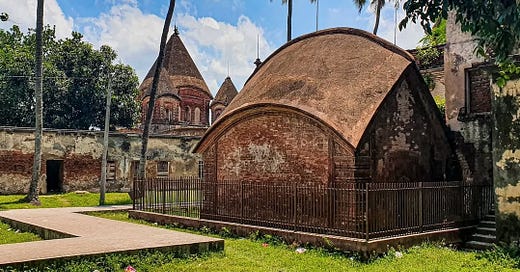Before I began to travel properly through Bangladesh, I had no real sense of just how rich, gorgeous, and heartbreakingly unprotected its architectural heritage truly is.
But beneath the silt-laden rivers and endless fields of rice lies a land dotted with forgotten mosques, crumbling temples, half-sunk stupas and palaces draped in bougainvillaea.
Nowhere captures this melancholy crumbley-ness better than the temple town of Puthia.
A short drive from Rajshahi, near the Padma River, it is the largest temple town in Bangladesh.
A Terracotta Temple Town
Tightly packed in this peaceful and largely forgotten town is the country's greatest concentration of Hindu heritage.
Today, politicians of depict the Mughal conquests of India as religiously motivated jihad, in which temples were torn down and mosques were built in their place. The temple town of Puthia somewhat messes up that picture.
Firstly, the leading Mughal general at the time was a Hindu - Man Singh. When Singh marched the Imperial Mughal armies into Northwest Bengal, it was the Muslim rulers of the enemy Bengal Sultanate who were targeted, not the Hindus of the province.
In fact the Mughals wanted to be seen as liberating Bengalis of all faiths from Sultanate rule. In Puthia, Man Singh seized the lands of a rebellious Muslim Pathan noblemen and gifted then to a Hindu holy man called Bhattacharya, whose local knowledge had been crucial in the war.
Bhattacharya was an ascetic and refused the land grant, but his son accepted in his stead. A generation later, the family were appointed 'Rajas' by the Emperor Jahangir, to thank them for their loyalty and support. Thus the Puthia Rajas were born.
Krishna and Jahangir in Terracotta
Over the following two centuries, the Puthia Rajas would adorn their fiefdom with numerous teracotta temples.
Perhaps the greatest of these is the Pancha Ratna Govinda Temple. Made entirely from terracotta, it features elaborate carvings of various epics - from the Mahabharata and the Ramayana, to the Gita Govinda, and even the occasional story from the Shahnameh.
Keep reading with a 7-day free trial
Subscribe to Travels of Samwise to keep reading this post and get 7 days of free access to the full post archives.









